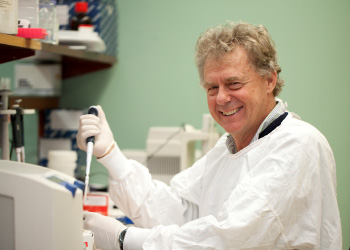March 21, 2016 Print
Researchers at The Westmead Institute in Sydney have used genetic evidence to discover how vitamin D may be protective against multiple sclerosis, paving the way for more targeted treatments.
 Professor David Booth
Professor David Booth
It has long been known that vitamin D deficiency is associated with autoimmune diseases such as multiple sclerosis (MS) but the exact mechanism has remained elusive.
With the help of a genetic clue from Multiple Sclerosis studies, researchers from the Institute’s Centre for Immunology and Allergy Research have identified how immune cells are controlled by vitamin D.
Westmead Institute researchers have also found that this control would impact other autoimmune diseases, such as Crohn’s disease and rheumatoid arthritis. The risk genes for all these diseases are regulated by vitamin D in particular immune cells.
According to Professor David Booth who leads the Westmead Institute’s Immunogenetic Research Group, the genetic link indicates how the long-observed increase in the risk of contracting MS among those who live in areas with less sunlight might be mediated.
“It’s long been known that your risk of getting MS depended on where you grew up,” Professor Booth says. “For example, if you grew up in North Queensland, your risk is tenfold lower than if you grew up in Tasmania. And that’s replicated around the world. The closer you are to the equator when you grow up, the less likely you are to get MS. It’s a very big difference.”
The key to their significant discovery was knowing where to look. Previous research has focused on the wrong types of immune cells.
Using genetic discoveries from a worldwide collaboration called the International MS Genetics Consortium – of which the Institute researchers were a part – Professor Booth and his team discovered that three known MS-risk genes which control vitamin D activation are “turned on” in specific cells called myeloid cells.
Myeloid cells are a type of immune cell found in the skin and lymph nodes. Until now, nobody has looked at these cells in relation to MS and vitamin D.
With the help of a powerful technique called ChIP-Seq, which analyses protein interactions with DNA, they found that the genes, including the risk genes, are controlled by vitamin D in the myeloid cells.
“That’s a smoking gun,” says Professor Booth. “It suggests that vitamin D controls tolerance through its gene regulation in these skin and lymph node immune cells. It tells you how vitamin D matters.”
However, before you rush off to take vitamin D pills or sunbake, the research, published in the journal Genes and Immunity last week shows that there are probably more effective ways of using vitamin D as an MS therapy.
“Until now, nobody knew how to benefit from this association of vitamin D and MS,” says Professor Booth. “The simplest idea is just to get vitamin D levels up by taking an oral supplement. But our research shows that this might not be the best approach.”
“By manipulating this genetic process we may be better able to use vitamin D and its many analogues in therapy, and also identify new therapeutic approaches, such as methods to control immune cell activation for cell-mediated therapy.”
“By manipulating this genetic process we may be better able to use vitamin D and its many analogues in therapy, and also identify new therapeutic approaches, such as methods to control immune cell activation for cell-mediated therapy.”
The next step for the researchers is to extend their examination to the entire spectrum of myeloid cell types to elicit a broader understanding of how vitamin D provides protection.
“In this study, we looked at three cell types, which were the ends of the spectrum. We will now look at 23 cell types – the entire spectrum – with this same technique. This should lead to a better way to manipulate the immune response.”
Professor Booth received a MS Research Australia Senior Research Fellowship from 2010 - 2014, which supported much of his initial work in this area and led to his subsequent Senior Research Fellowship and project grant from the National Health and Medical Research Council in 2015.
Multiple sclerosis (MS) is a condition of the central nervous system, interfering with nerve impulses within the brain, spinal cord and optic nerves. According to MS Australia, MS affects over 23,000 people in Australia, with most people diagnosed between the ages of 20-40.